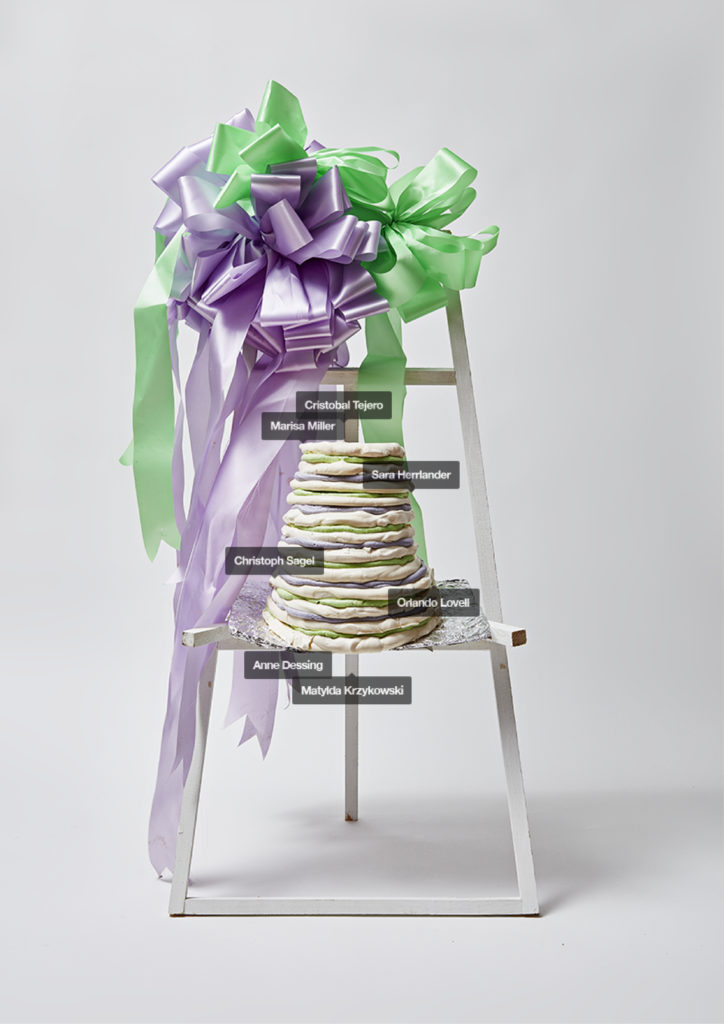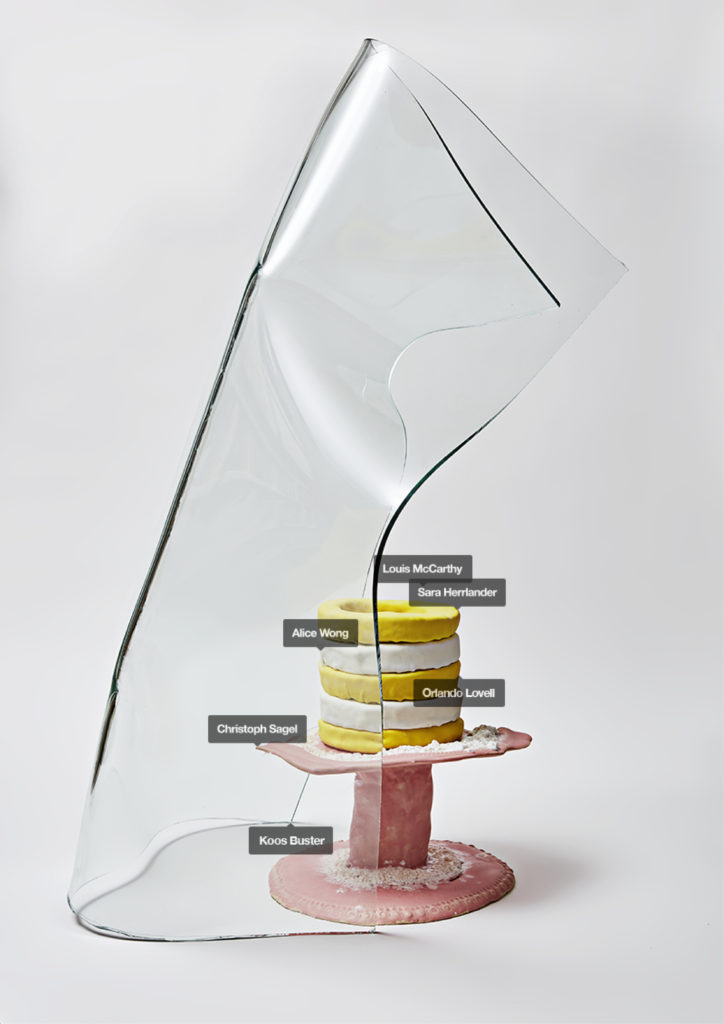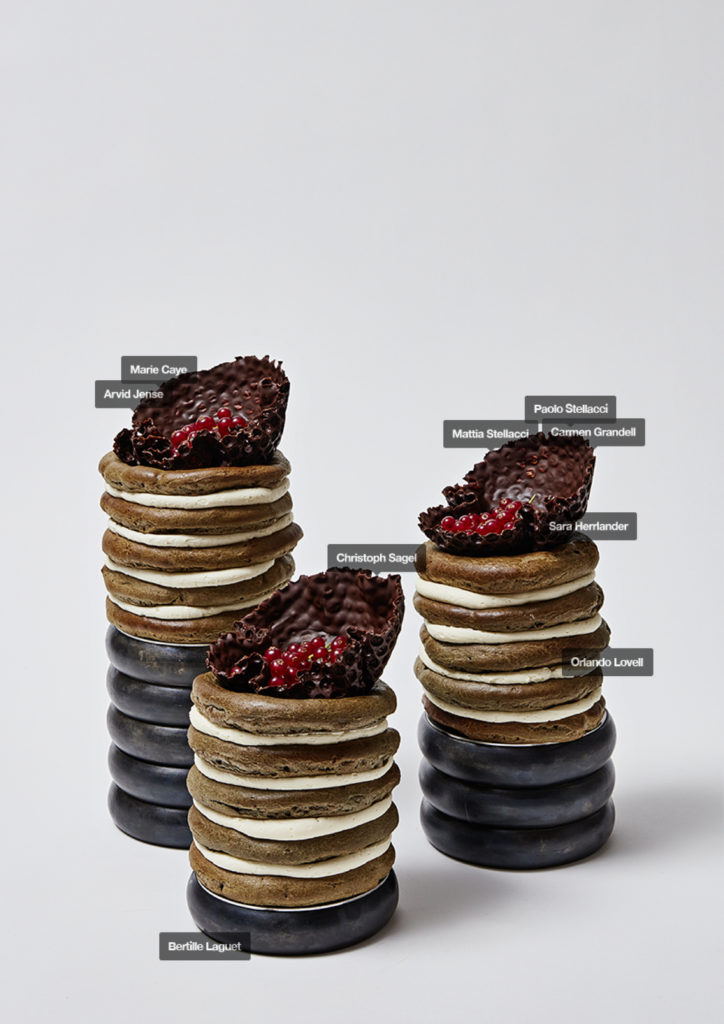A creative relationship between multiple people that goes beyond a single outcome.

As today’s relationships, romantic and otherwise, are changing with the increased visibility and information access through social media platforms, so too are collaborations. This project proposes a rethinking of the term collaboration as a “creative relationship”. Viewing a collaboration as a creative relationship means consent, appreciation, curiosity and dialogue can be shared under a new light.
Polycreative is a concept that showcases a different way of approaching collaborations as creative relationships with multiple people working together both physically and virtually. This project
focuses on representing and celebrating these relationships through cake. In three main stages, design and process is influenced by different creative individuals in terms of form, function, visualisation, etc. For Polycreative, the final outcomes become secondary, the primary aspect is the communication, the many different media used, and the different emotional experiences had.
How much influence does one creative have in the different stages of a process? How are ideas and concepts shared across long distances? And how does the final representation reflect all involved?
Five different creative relationship scenarios were conducted with several designers; creative exchange, dialogue and symbiosis were recorded at each stage, thereby showing different creative pathways and ways of working explored in a creative relationship. In this example, I was the initiator, facilitator and maker of the cakes, which were the connective medium. My primary creatives were designers who were asked to each design and make a cake stand, the secondary creatives were designers who were asked to create new eating rituals in reaction to a specific cake and stand. Another level of creatives contributed their skills through photography, cinematography, technical support and performance.
Concept and Execution: Orlando Lovell
Cake Designs: Orlando Lovell
Photography: Christoph Sagel
Cake Stand Designers: Koos Buster, Anne Dessing, Matylda Krzykowski, Bertille Laguet, Philippe Malouin
Ritual Designers: Arvid & Marie, Sarah Illenberger, Marisa Miller, Giulia Soldati, Alice Wong

polycake n°1
The story behind this stand is a classic one. I met the designer Philippe Malouin for the first time at a design event in 2011. Each time we met again at different events, we connected over design education and stories about the Design Academy Eindhoven, where he also studied. We became Facebook friends. I have always enjoyed his posts about his work, but also about his social life – which seems to be full of people, parties and pleasure. When I asked him if he would be interested in designing a cake stand for me, I expected a negative response, but to my great surprise he agreed.
His assistant Joshua Garcia sent me a full product pdf just 14 days after my first email. He explained to me that the 8mm thick folded stainless-steel design was intended to be both monumental and minimal, to distract as little as possible from any details the cake might have: a simple and clean supporting function.
I made a multi-layered and detailed cake to go with it. Its architectural forms and textures are a response to the monumental pillar-like structure of the (exceptionally heavy) base. The pink lemon filling and sponge inside was a happy surprise – much like Philippe’s participation turned out to be for me.
I then passed on the image of the cake and stand, along with the story above, to the artist, illustrator and designer, and another inspiration and mentor for me, Sarah Illenberger, who devised and scripted a performative social practice, which I then organised, directed and filmed in Berlin.
“As the tent has an architectural feel for me, I would create a similar space to eat it inside.
Using rolls of frosted paper and sticks for the structure, I would create a beautiful round tent. This tent would be set up in the countryside. Maybe next to my favourite oak tree. I would place a disco light in the middle, some soft cushions to sit on and many blankets for comfort. I would invite a handful of my best friends, hand them each a wooden spoon and have them eat it. As coffee is vital for a cake like this, I would use a camp fire and espresso machine to make some good coffee. This is perfect cake eating comfort zone to me.” – Sarah Illenberger
Cake Stand: Philippe Malouin, Joshua Garcia
Cake: Orlando Lovell
Cake Photography: Christoph Sagel
Styling: Orlando Lovell
Ritual Design: Sarah Illenberger
Ritual Filming: Sara Herrlander
Film Direction & Editing: Orlando Lovell
Ritual Performance: Sergey Antsiperov, Maria Bowman, Jonas Lampsatis, Inés Lauber, Charlotte Pietrock

polycake n°2
The story behind this cake stand is a very personal one. I have known the designer and maker Koos Buster for four years now. I met him when he was one of my oldest friends’ boyfriend and sadly re-encountered him at her funeral now nearly two years ago.
Though we did not know each other well, we were united in grief for our friend and loved one. As Koos Buster was graduating from Rietveld Academy with his unique and outstanding ceramic works last summer, we joked about making cakes that looked like his ceramic cleaning products, so when the idea for this project came along, I had no
doubt that he had to be one of the cake stand makers. He agreed immediately, even though he was already inundated with work and new commissions. When he arrived in Berlin from Amsterdam by car some weeks later, it was with the joyful news that he is to be a father next year. He also brought a pink cake stand with foam glaze and a huge
asymmetric glass cover to go with it, I was taken by surprise but quickly fell in love with the piece.
My cake in response became a playful structure with layers of blue cake covered in alternative yellow and white fondant with a hole in the centre. I then passed on the image of the cake and stand, along with the story above, to the secondary designer Alice Wong, who devised and scripted a performative social practice, which I then organised, directed and filmed in Berlin.
“After reading this story, I came up with a ritual to reconnect with a long-lost friend, to honestly express what has been hanging around in our minds – it’s time to let it out. You must call a long-lost friend and share a memory the two of you have. I think this can be challenging, but I think it’s a healthy dose of challenge that deserves a little celebration with the lovely comfort of cake. I see the glass table as a telephone booth, to give a little shelter, a little privacy for the person who will be talking on the phone.” – Alice Wong
Cake Stand: Koos Buster
Cake Photography: Christoph Sagel
Styling: Orlando Lovell
Ritual Design: Alice Wong
Ritual Filming: Sara Herrlander
Film Direction & Editing: Orlando Lovell
Ritual Performance: Louis Mccarthy

polycake n°3
The story behind this cake stand is a short but connected one. One of the first people I wrote to at the start of this process was the designer and curator Matylda Krzykowski. I had been her intern the previous year and trust her when it comes to match-making in the design world.
To my surprise she herself said “yes” to my proposal and offered to make me a one-off cake stand from her new home in Chicago. She also suggested Anne Dessing, an architect from Amsterdam, who later turned out to be her flatmate. I loved the idea of having an architect join the team to get a new perspective on scale and also the idea of a “blind date”. Anne and Matylda ended up making two stands together trig-
gered by their first impressions of Chicago, specifically the Hispanic area where they lived together.
The two pieces are “intended assemblages”, made in the local modus operandi: taking existing structures and familiar ornaments and combining them for festive moments.
My cake for the stand is a reflection on colour and celebration. The rough-textured surface is instinctual with edible confetti impulsively thrown across it. The filling is a classic I perfected during my internship with Matylda due to her unquenchable appetite for it: salted caramel cake. I then passed on the image of the cake and stand, along with the story above, to the secondary designer, and former flatmate of my own, Giulia Soldati, who devised and scripted a performative social practice, which I then organised, directed and filmed in Berlin.
“This ritual shows the importance of collaboration and sharing. All the hands that collaborated in creating both the stand and the cake are shown in a layering of actions. The moment of preparation and the moment of consumption blur, becoming a choral action, so do the eating and preparing tools: the same tools will be used to finish and eat the cake. The preparing and the eating become convivial moments of sharing, of festive celebration, a new ritual of creation and consumption.” – Giulia Soldati
Cake Stand:Matylda Krzykowski, Anne Dessing
Cake Photography: Christoph Sagel
Styling: Orlando Lovell
Ritual Design: Giulia Soldati
Ritual Filming: Sara Herrlander
Film Direction & Editing: Orlando Lovell
Ritual Performance: Felipe Argüello, Max Best, Enda Crowley, Kevin Klaus, Orlando Lovell

polycake n°4
The story behind this cake stand is a short but connected one. One of the first people I wrote to at the start of this process was the designer and curator Matylda Krzykowski. I had been her intern the previous year and trust her when it comes to match-making in the design world. To my surprise she herself said “yes” to my proposal and offered to
make me a one-off cake stand from her new home in Chicago. She also suggested Anne Dessing, an architect from Amsterdam, who later turned out to be her flatmate. I loved the idea of having an architect join the team to get a new perspective on scale and also the idea of a “blind date”.
Anne and Matylda ended up making two stands together triggered by their first impressions of Chicago, specifically the Hispanic area where they lived together. The two pieces are “intended assemblages”, made in the local modus operandi: taking existing structures and familiar ornaments and combining them for festive moments.
My cake for the stand reflects this through many layers of meringue, sandwiched between layers of alternating purple and green soft cream cheese frosting, matching the colours of the celebratory ribbons on the stand. I then passed on the image of the cake and stand, along
with the story above, to the secondary designer Marisa Miller, who devised and scripted a performative social practice, which I then organised, directed and filmed in Berlin.
“My response was to the cake stand’s physicality. I’ve been mining the relationship between a cake server and a receiver who gets cake pressed in their face, based on an interest in illuminating the desire for cruelty (and the fetishization of weakness). Because of the stand’s delicacy, its flimsy foil base balanced on an ad-hoc open assemblage, the action and dynamic had to become more delicate to match the situation.” – Marisa Miller
Styling: Orlando Lovell
Ritual Design: Marisa Miller
Ritual Cinematograph: Sara Herrlander
Film Direction & Editing: Orlando Lovell
Ritual Performance: Marisa Miller, Cristóbal Tejero

polycake n°5
The story behind these cake stands is that I asked a friend for a recommendation for the project. They gave me the name of the Swiss designer and blacksmith Bertille Laguet. Like with a blind date, I checked her (work) out on the internet, and then just wrote to her with no great expectations.
To my surprise she replied and told me that her grandfather was a pastry chef and her great-uncle was the White House pastry chef for 25 years. I was stunned by the immediate connection and we both quickly became enthusiastic about working together. The metal rounds of her triptych design were forged and hammered by hand in a repetitive body motion. There are stainless-steel plates on the tops and bottoms, for food hygene. Each stand is stamped with both our names on the base. We talked about the cake mimicking the shape of the stand and I took a long time to find what I wanted to make, because I felt a great desire to do the stands justice and ended up hand-piping rings of coloured choux pastry. It took many tries to get them right and was the longest process and the most technically difficult of all the cakes in this project.
I then passed on the image of the cakes and their stands, along with the story above, to the secondary designers Marie Caye and Arvid Jense who devised and scripted a performative social practice, which I then organised, directed and filmed in Berlin.
“We were inspired by the story of the stand designer who created the stand in repetitive motions. We wanted to create a ritual around the idea of manufacture/mass production. Both the cake and the stand are unique crafted objects can we standardise them? We tried to deconstruct the cake in single bites to be eaten in rhythm.” – Arvid&Marie
Styling: Orlando Lovell
Ritual Design: Arvid & Marie
Ritual Cinematograph: Sara Herrlander
Film Direction & Editing: Orlando Lovell
Ritual Performance: Carmen Grandell, Mattia Stellacci, Paolo Stellacci